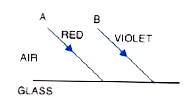Sharks and dogfishes differ from skates and rays by
Their pectoral fins distinctly marked off from cyclindrical bodies
Gill slits are ventrally placed
Head and trunk are widened considerably
Distinct demarcation between body and tail
The correct Answer is:A
To answer the question about how sharks and dogfishes differ from skates and rays, we can follow these steps:
1. Understand the Characteristics of Sharks and Dogfishes:
- Sharks and dogfishes have elongated bodies with pectoral fins located behind their heads on either side.
- Their pectoral fins are rigid and elongated, supported by cartilaginous structures called keratorrhicoids.
- These fins help them maintain buoyancy and maneuverability in the water.
2. Understand the Characteristics of Skates and Rays:
- Skates and rays have flattened, disc-like bodies.
- They possess five gill slits located on the underside of their bodies, and their mouths are also situated on the underside.
- Their large pectoral fins are shaped like wings, allowing them to glide through the water, and they have long, cylindrical tails.
3. Analyze the Given Options:
- Option 1: "Their pectoral fin distinctly marked off from cylindrical bodies."
- This option is correct as sharks and dogfishes have pectoral fins that are clearly separated from their cylindrical bodies.
- Option 2: "Gill slits are ventrally placed."
- This is incorrect for sharks and dogfishes, as their gill slits are not ventrally placed.
- Option 3: "Head and trunk are widened considerably."
- This is also incorrect; sharks and dogfishes do not have a considerably widened head and trunk compared to skates and rays.
- Option 4: "Distinct demarcation between body and tail."
- This is incorrect as well; while skates and rays have a more integrated body structure, sharks and dogfishes do not have a distinct demarcation.
4. Select the Correct Option:
- Based on the analysis, the correct answer is Option 1: "Their pectoral fin distinctly marked off from cylindrical bodies."
Final Answer:
Sharks and dogfishes differ from skates and rays primarily in that their pectoral fins are distinctly marked off from their cylindrical bodies.
---
- Sharks and dogfishes have elongated bodies with pectoral fins located behind their heads on either side.
- Their pectoral fins are rigid and elongated, supported by cartilaginous structures called keratorrhicoids.
- These fins help them maintain buoyancy and maneuverability in the water.
- Skates and rays have flattened, disc-like bodies.
- They possess five gill slits located on the underside of their bodies, and their mouths are also situated on the underside.
- Their large pectoral fins are shaped like wings, allowing them to glide through the water, and they have long, cylindrical tails.
- Option 1: "Their pectoral fin distinctly marked off from cylindrical bodies."
- This option is correct as sharks and dogfishes have pectoral fins that are clearly separated from their cylindrical bodies.
- Option 2: "Gill slits are ventrally placed."
- This is incorrect for sharks and dogfishes, as their gill slits are not ventrally placed.
- Option 3: "Head and trunk are widened considerably."
- This is also incorrect; sharks and dogfishes do not have a considerably widened head and trunk compared to skates and rays.
- Option 4: "Distinct demarcation between body and tail."
- This is incorrect as well; while skates and rays have a more integrated body structure, sharks and dogfishes do not have a distinct demarcation.
- Based on the analysis, the correct answer is Option 1: "Their pectoral fin distinctly marked off from cylindrical bodies."
Sharks and dogfishes differ from skates and rays primarily in that their pectoral fins are distinctly marked off from their cylindrical bodies.
Topper's Solved these Questions
- ANIMAL KINGDOM (CHORDATES) BOOK - AAKASH INSTITUTE ENGLISHCHAPTER - ANIMAL KINGDOM (CHORDATES) EXERCISE - Assignment (Section-D)
10 Videos
- ANIMAL KINGDOM (CHORDATES) BOOK - AAKASH INSTITUTE ENGLISHCHAPTER - ANIMAL KINGDOM (CHORDATES) EXERCISE - Assignment (Section-B)
11 Videos
- ANATOMY OF FLOWERING PLANTS BOOK - AAKASH INSTITUTE ENGLISHCHAPTER - ANATOMY OF FLOWERING PLANTS EXERCISE - Section D Assertion-Reason Type Questions
10 Videos
- ANIMAL KINGDOM (GENERAL ACCOUNTS & NON-CHORDATES)BOOK - AAKASH INSTITUTE ENGLISHCHAPTER - ANIMAL KINGDOM (GENERAL ACCOUNTS & NON-CHORDATES)EXERCISE - Assignment (Section-D)
10 Videos
Similar Questions
Knowledge Check
Sharks and bony fish are different in that only :
Abony fish have paired finsBbony fish have an operculumCsharks have a bony skeletonDsharks are predaceousSmall fish get stuck near the bollom of a shark and derives its nutrition from it. This kind of association is called
AAntibiosisBCommensalismCPredationDParasitism
How do cathode rays differ from anode rays?
View Solution(a) State three properties which are common to both the beta rays and cathode rays.
(b) How do beta rays differ from cathode rays ?
View Solution(A]: The relationship between sucker fish and shark is considered to be an example of parasitism.
[R]: Sucker fish gets food and shelter from shark and also alters the population growth of the shark
View SolutionThe diagram below shows two parallel rays A and B of red and violet light respectively incident from air on air-glass boundary. Complete the diagram showing the refracted rays for them in the glass.

(i) How do the speeds of the rays differ in glass ?
(ii) are the two refracted rays in glass parallel ?
Give a reason for your answer.
(iii) How does the refractive index of glass differ for the two rays ?
View SolutionA ray of light passes from medium 1 to medium 2. which of the following quantities of the refracted ray will differ from that of the incident ray speed, intensity, frequency, and wavelength ?
View SolutionSmall fish get stuck near the bottom of a shark and derives its nutrition from it. This kind of association is called as :
View Solution
